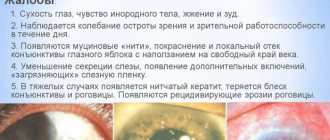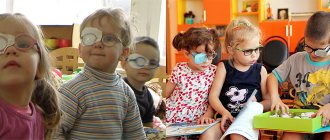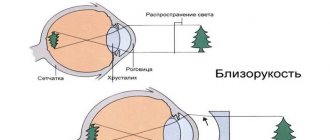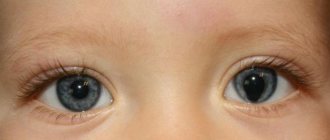Definition of vision
Man is endowed by nature with five senses that allow him to perceive the world around him.
Vision is a person’s ability to perceive information by converting the energy of electromagnetic radiation in the light range.
In order for us to see, our visual apparatus does a very complex job. The eye picks up optical stimuli, processes them into nerve impulses that are transmitted to the cerebral cortex, to the area responsible for processing them and forming a certain image. This complex process involves the extraocular muscles, the optical system of the eye, the structure of which includes the cornea, lens, iris and vitreous body, optic nerve and visual centers of the brain. If a functional failure occurs in any of these elements, it causes vision impairment. Damage to different structures manifests itself in different disorders.
A person receives more than 80% of information through vision. Visual impairment partially or completely deprives him of this opportunity. Visually impaired people are not uncommon these days.
Types of violations
Let's look at the main and most common types of visual impairments.
Myopia
With myopia, a person has difficulty distinguishing objects at a distance. The higher the degree of myopia, the weaker he sees into the distance. With myopia, the image of an object is focused not on the retina, but in front of it. This may be due to curvature of the cornea, elongation of the eyeball, or both. Most often, myopia is detected in adults who spend a lot of time at the computer and in school-age children, since at this time the load on the eyes increases several times. This disorder can be corrected with glasses and lenses, as well as through surgery.
Minor visual impairment can be corrected with special visual exercises.
Farsightedness (hypermetropia)
Farsightedness is caused by abnormal curvature of the cornea, insufficient eyeball size, or both. With hypermetropia, the image is projected not on the retina, but in the plane behind it. With moderate and high farsightedness, the image will be blurry both near and far. This disorder often occurs in childhood, but does not always indicate weakened vision. Children's farsightedness is normal when it is caused by the small size of the eyeballs. As the child grows, the pathology goes away on its own, but the process needs to be monitored by regularly visiting an ophthalmologist.
Astigmatism
With astigmatism, the surface of the eyeball becomes oval, like a rugby ball. Normally, the eye has an absolutely round surface. This visual impairment is expressed by improper focusing. Rays of light passing through the eye are projected on the retina at two points, making objects blurry.
Astigmatism often develops in childhood, usually at the same time as farsightedness or nearsightedness. If left uncorrected, this disorder can cause a sharp decrease in visual acuity and also cause strabismus.
Strabismus (strabismus)
Strabismus is the deviation of one of the eyes from the common point of fixation, which makes it impossible to merge two images into one. Strabismus occurs due to decreased visual acuity in one or both eyes or due to impaired refraction and accommodation.
Treatment of strabismus in adults is described here.
Amblyopia
This disorder is popularly called “lazy eye.” It develops when there is a difference in the refractive ability of the eyeballs or is caused by congenital anomalies of one of them, and is also a consequence of untreated strabismus. As a result, a fuzzy image is transmitted to the brain, and it simply suppresses the work of one eye. In this case, there is a deterioration in visual acuity.
Child with ablyopia
If amblyopia is left untreated, visual acuity will deteriorate.
Myopia (nearsightedness)
Myopia in children is one of the most common eye diseases. With myopia, a person sees objects that are close up well and objects that are far away poorly. Signs of myopia are obvious: the child squints when he needs to see something at a distant distance, when watching TV he tries to sit closer, when reading he brings a book close to his eyes. Due to constant tension, headaches may begin and fatigue may occur. Most often, myopia is diagnosed at the age of 9-12 years. During adolescence it may intensify. If myopia is detected, the ophthalmologist prescribes vision correction - glasses or lenses. Drug treatment may be prescribed - eye drops, strengthening vitamins. It is advisable to do eye exercises. High myopia may require surgery.
According to the degree of violations
The degree of visual impairment is determined by the level of decrease in visual acuity - the ability of the eye to see 2 luminous points with a minimum distance between them. Normal visual acuity, equal to one - 1.0, is taken to be a person’s ability to distinguish letters or signs of the tenth line of a special table at a distance of 5 meters. The difference in the ability to distinguish characters between the next and the previous lines means a difference in visual acuity of 0.1.
There are several groups of people with visual impairments:
- Blind people are people with a complete absence of visual sensations or with residual vision, as well as retaining the ability to perceive light.
- Totally blind are persons with a complete absence of visual sensations.
- Partially blind people are people who have only light perception.
- Visually impaired - persons with visual acuity from 0.05 to 0.2. Their difference from the blind is that with a pronounced decrease in the acuity of perception, the visual analyzer remains the main source of perception of information about the surrounding world and can be used as a leader in the educational process, including reading and writing.
Depending on the time of appearance of the defect, there are 2 categories of blind people:
- Born blind are people with congenital total blindness or who became blind before the age of 3 years. They have no visual ideas, and the entire process of mental development is carried out in conditions of complete loss of the visual system.
- Blind people are people who lost their sight in preschool age and later.
How does the disease develop in children?
Almost all children are born with a diagnosis of farsightedness (hyperopia), but, as a rule, most of them acquire close to normal vision by the age of 10. An average degree of farsightedness (up to + 5 diopters) is the norm for young children, since at the time of birth the eyeball is shorter than necessary. But as the baby grows, the eyeball also grows.
Newborn babies are usually born with an average degree of farsightedness (about +3 diopters). As the visual system develops and further forms, the number of diopters decreases, and by 3 years it is about +1 or +1.5 diopters. But sometimes children are born with a high degree of farsightedness, which does not decrease as the child grows older. And in order to identify this, it is very important to regularly see an ophthalmologist.
Ophthalmologists should monitor the trend of improvement in the refraction of the eye. The first examination is carried out at approximately 6 months of age, the second at one year of age. The norm for a one-year-old baby is farsightedness of +2.5 diopters.
WHY IS VISION IMPAIRED?
The eye is an organ of perception that serves us faithfully throughout our lives, so deterioration in the functioning of the eye must be treated with great attention. Knowing the causes of visual impairment, you can cure the first symptoms of diseases in time.
If your vision begins to deteriorate, then you need to urgently go to the doctor. The fact is that in addition to direct eye diseases, the quality of vision can be affected by diseases that affect the nervous system or blood vessels of the eyeball, as well as various pathologies of the tissues around the eyes.
Watery eyes are one of the first signs that your vision needs help. In addition, “floaters”, loss of clarity, pain and redness pose a danger.
HOW DOES INTERFERENCE OCCUR IN THE EYE?
The eye is a complex optical device. Before a picture is formed in the human brain, light must go through several stages. Violations that occur in at least one of them can lead to a deterioration in the quality of images received from the outside. Thus, most problems with visual acuity are associated with pathologies of the retina.
Visual acuity is the ability of the eye to distinguish between two points at a certain distance. It is measured in conventional units: for a healthy eye, visual acuity is equal to one.
If there are obstacles in the path of light to the retina, visual acuity decreases. For example, if negative changes occur in the lens or cornea, a person’s vision may become blurred, and spots often appear before the eyes in such cases.
If the lens is shaped incorrectly, the positioning of the image on the retina is deformed, which leads to poor image quality. With weakened eye muscles, as well as overgrown fatty tissue of the eye, double vision and distortion of visible images are possible.
After light hits the retina, certain nerve impulses are immediately sent to the brain. Therefore, if there are any disturbances in the functioning of the nervous system, a person experiences distortions in visual images. As a rule, they are quite specific depending on the specific nervous disorder (even false images - hallucinations).
FATIGUE IS THE CAUSE OF VISION PROBLEMS
The pace of modern life is constantly accelerating. A person is required to quickly respond to various challenges, as well as absorb a huge amount of information throughout the day. Most new information enters the brain through the eyes.
Therefore, very often there are cases when vision is impaired not because of diseases of the lens or retina, but because of severe and constant overwork, lack of sleep, stress and prolonged visual strain that occurs in a person when working at a computer.
If you notice that visual acuity decreases towards the end of the day, if your eyes become red and hurt, then to eliminate unpleasant symptoms you need to relax, have a good rest and do special exercises for the eyes.
If you are concerned about how to preserve your vision for a long time, it is recommended that you immediately visit an ophthalmologist at the first signs of visual impairment to exclude the possibility of developing dangerous diseases. After all, eye ailments are a serious problem that should not be taken lightly.
DISEASES CAUSING VISUAL IMPAIRMENTS
The retina is most often affected - vision deteriorates due to the following pathologies:
- retinal detachment;
- mauclodystrophy – lesions of the retinal area with the largest number of receptors;
- vitreous detachment;
- retinal tear;
- diabetic retinopathy – damage to the small vessels of the eye and impaired blood supply to the eyeball.
When the lens is damaged, visual impairment is caused by the following diseases:
- cataract (clouding of the lens);
- myopia;
- farsightedness.
Source https://www.proboxs.ru/novosti/zdorove/osnovnye-prichiny-narusheniya-zreniya.html
Causes of visual impairment in children
There are many reasons for visual impairment in preschool children, but the primary role is given to physiological eye fatigue and impaired accommodation. A rich curriculum in kindergarten and school, educational games and watching cartoons on the computer - all this contributes to the development of myopia.
But a child’s busy schedule only creates the preconditions, and the true enemies of good vision are:
- bad light;
- incorrect selection of furniture for classes;
- heredity;
- deficiency of vitamins and minerals in the diet;
- lack of work and rest schedule.
Some diseases can also play a role - acute respiratory viral infections, diabetes mellitus and others.
Therefore, preventing vision loss in children comes down to organizing a workspace and rest regime, monitoring the diet and enriching it with vitamins and minerals. In addition, schoolchildren need to visit an ophthalmologist at least once a year, and if symptoms of myopia are detected, every six months.
Vision problems in children
Good vision is an indispensable condition for the health and full development of a child. It is through vision that a child acquires basic communication skills, forms an idea of the world around him and his own vision. This is where the development of the child’s personality begins.
If a child's visual acuity is reduced, the baby's development can be significantly hampered, so questions about children's vision are extremely important. Vision problems in a child primarily affect parents, because they are responsible for the health of their child. Under no circumstances should these problems be allowed to arise.
Causes
It is impossible to treat visual impairment in children if you do not know their causes. So, the main factors of visual impairment in children are:
- Hereditary predisposition;
- Stress;
- Reduced hemoglobin level;
- Poor visual hygiene (reading in low light conditions, reading or playing on a mobile phone while lying down, working on a computer, etc.);
- Failure to comply with visual safety rules: manipulation with sharp objects, addiction to looking at bright light without glasses.
The most common vision disorder in children is myopia. This is due to the fact that the age from 7 to 15 years is combined with increased visual stress (reading, writing, school lessons). Failure to follow the rules of watching TV and working with a computer, genetic predisposition, nutritional deficiencies and other negative factors can lead to the development of strabismus, myopia, amblyopia and other vision problems in children.
Any visual impairment or eye disease in a child requires immediate medical attention. Remember: the earlier treatment is started, the greater the chances of a full recovery and no problems in the future, regardless of the cause of visual impairment in children. Preserving children's vision is an important responsibility of parents.
Features of psycho-emotional development
Deficiencies in visual perception lead to the formation of fuzzy, unclear images and ideas in the child, and negatively affect the development of mental operations (synthesis, analysis, comparison, generalization, etc.), which leads to difficulties when studying at school and mastering educational material. In addition, visual impairment significantly narrows the scope of sensory cognition, thereby affecting the general qualities of emotions and feelings, their significance for life, and therefore the formation of a person’s personal qualities. Children often feel doomed and useless, and this depressed state leads to slower intellectual growth.
Psychologists note that children with visual impairments have the following specific features:
- They have an increased personal level of anxiety;
- Children have a poorly developed emotional-volitional sphere;
- Poor correlation of emotion with facial expression;
- Insufficiently competent in expressing emotions;
- Poorly understand the facial expressions of other people's emotions.
Features of physical development
Visual impairment in children complicates spatial orientation, delays the formation of motor skills, and leads to a decrease in motor and cognitive activity. Some children experience a significant delay in physical development: the correct posture when walking, running, natural movements, and outdoor games is impaired, coordination and accuracy of movements are impaired.
Visual impairment leads to secondary deviations in the physical development of children. Many children with visual impairments have a low level of development of tactile sensitivity and motor skills of the hands and fingers.
Due to the absence or sharp decrease in vision, children cannot spontaneously, by imitation of others, master various objective and practical actions, as happens in children with normal vision. Because of this, the arm muscles become sluggish or, conversely, too tense. All this leads to a low level of development of tactile sensitivity and hand motor skills and negatively affects the formation of subject-related practical activity.
Treatment for children's vision should be affordable
Igor Erikovich AZNAURYAN, pediatric eye surgeon, pediatric ophthalmologist, Doctor of Medical Sciences, academician of the Academy of Medical and Technical Sciences of the Russian Federation, founder and director of the specialized system of children's eye clinics "Yasny Vzor" in Russia.
How is the direction of work of the Yasny Vzor clinics radically different from existing ophthalmological centers in Russia?
— Yasny Vzor clinics are the first and only system of eye clinics that specializes in the treatment of eye pathologies specifically in children. There are no similar medical institutions in Russia. There are small children's additional departments at eye clinics, but the emphasis there in any case is on treating the eyes of adults.
All our departments have specially trained personnel who know the peculiarities of the formation and development of the visual system in children and can always find an approach to even the most special child.
The technologies that we introduce into the practice of our clinics in all divisions (today we have 9 divisions in Russia) are strictly controlled by the relevant medical structures. This minimizes the possibility of errors or undertreatment.
We are trying to make modern effective medical care for children with eye pathologies, firstly, accessible, and secondly, as effective as possible. Effectiveness is achieved, as I have already said, through unified control. We have developed standards for the diagnosis and treatment of children's eye diseases, which reduce to zero the possibility of error in determining the diagnosis of a child. These standards are based on our 30 years of experience and the experience of our Western colleagues - we borrowed the basis of the standards from them and improved them.
Now Western ophthalmologists admit: our standards are more effective than those used in individual countries of Western Europe or individual states of the USA.
We consider treatment based on a deep understanding of the mechanisms of the origin of the disease and the impact on the mechanism itself. It is important to clearly determine what exactly led to the pathology, where the “breakdown” occurred, which then caused a series of symptoms. And only then begin treatment. Our approach is comprehensive, which is why we achieve effective, sustainable results in treatment.
We have joint projects with our colleagues from the United States; a new technology has recently been created, which is now at the implementation stage. It will be very effective in treating patients with strabismus.
“Yasny Vzor” is a non-state clinic, but you can get treatment under the compulsory medical insurance policy?
— High-quality treatment should be as accessible as possible. Our clinics, indeed, belong to a rare category of non-state institutions that have undertaken to provide medical care within the framework of the compulsory health insurance (CHI) system. This makes our assistance financially accessible and can significantly reduce the financial costs of parents for the treatment of their children.
Yasny Vzor clinics have new, expensive techniques that compulsory medical insurance does not cover, but in any case, compulsory medical insurance significantly reduces the cost of treatment - by 30-50%, depending on the service. In some cases, we can provide specialized ophthalmological care to children free of charge within the framework of the state compulsory medical insurance register.
In addition, we were the first to implement the principle of territorial proximity and accessibility of specialized effective modern high-tech medical care, as well as a comfortable level of service and patient management.
Every year we open new clinics to make our help more accessible geographically.
What age patients are accepted at Yasny Vzor clinics?
— From 0 to 18 years. It is enough for the child’s parent to have his own passport, and also, let me remind you, a compulsory medical insurance policy - if the parent wants to reduce the cost of services by 30-50%.
What problems do patients most often come to you with?
— With myopia (myopia), hypermetropia (farsightedness), astigmatism, strabismus, nystagmus, obstruction of the nasolacrimal duct. We undertake the treatment of any pediatric pathology.
Yasny Vzor clinics treat strabismus and nystagmus. What is the fundamental difference between your methodology and existing ones?
“We can completely rehabilitate a patient with strabismus and nystagmus - these are diseases that were previously considered incurable. We achieve such results through the use of high-tech radio wave surgery for strabismus and nystagmus, of which we are the authors. There are no analogues of this technology in the world.
By the way, myths about the incurability of these pathologies are still widespread even among fellow eye surgeons.
Treatment of strabismus. Surgeries for strabismus in children are high-tech, effective and safe surgery.
Nystagmus is a disease associated with instability of the eye position and deep lesions of the visual system, when gaze is not fixed. Today we have been able to significantly improve the quality of life of these patients. To the point that such children begin to go to regular schools. That is, significant rehabilitation occurs not only in medical terms, but also in social terms.
The difference between our technique is that when performing operations we do not use traditional scalpels and scissors. We abandoned their use in favor of radio wave technologies. This provides a number of advantages:
- low-injury
- organ preservation - we don’t cut anything off, we preserve the structures of the eye
- The patient is discharged from the hospital the next day
- no swelling
- rehabilitation time is reduced by 6-8 times.
And that's not it. When performing operations on the eyes and extraocular muscles, especially in children, accuracy is extremely important. And we ensure this accuracy. In addition, we can demonstrate and guarantee this accuracy even before the operation.
How?
— We have developed a mathematical model for calculating the operation - Strabo. It is its use that allows us to achieve high accuracy - up to 0.5 degrees - these are the highest accuracy rates in world practice today. We enter the data of a specific patient (child or adult) and mathematically calculate each operation.
Mathematical model for calculating the STRABO operation to correct strabismus, Doctor of Medical Sciences Igor Erikovich Aznauryan. The model allows you to individually calculate each stage of the operation and show the result to parents before the operation):
Before surgery.
After operation.
Can the specialists of your clinics cure such a problem as “lazy eye”?
— We are the authors of a unique technology for the treatment of amblyopia – “lazy eye”. With amblyopia, even with glasses, vision remains poor. And we have developed a unique device - a binocular optometric complex, thanks to which we can relieve a child of glasses and significantly improve the quality of life. And not only in children, but also in adults.
The binocular optometric complex allows you to cure even the most complex types of amblyopia.
Tell us about the causes of vision problems in childhood. What is this most often associated with and why?
— More often these problems are congenital or, unfortunately, have a genetic predisposition. In addition, excessive visual stress in early childhood - passion for watching TV programs, computers, gadgets - contributes to the development of eye pathology even in the absence of such a predisposition.
At what age can problems be detected in a child?
- At 6-7 months. Parents on their own will not be able to determine whether the child has a pathology, unless there are obvious oculomotor disorders. Moreover, at an older age, when the baby is already beginning to speak, he will not complain about poor eyesight.
After all, with a congenital disease, the child does not even know what it means to “see well”!
Therefore, it is extremely important to regularly show the child to a specialist - a pediatric ophthalmologist who knows the peculiarities of the formation and development of the children's visual system.
Why visit a pediatric ophthalmologist?
— The visual system of a child differs from the visual system of an adult; there is a different list of pathologies. A specialist who knows the peculiarities of the formation of a child’s visual system will be able to correctly diagnose and prescribe additional examinations that will help to understand the mechanism and cause of the development of the disease. It is important to treat not the symptom, but the cause. We talked about our approach to treatment above.
If a child begins to see poorly, it is important not only (and not so much) to create comfortable conditions and put on glasses “so they can see.” It is important to carry out therapeutic measures aimed at increasing visual acuity and preventing the development of complications.
And if there is no pediatric ophthalmologist in the clinic, what should you do? What should parents do in this situation?
- Contact a specialized eye clinic - specialists from the Yasny Vzor clinics. Moreover, some services can be obtained under the compulsory medical insurance program for children from any region.
How can you preserve your children's vision?
— I advise parents to regularly see their child at a pediatric ophthalmologist. Limit your child's visual stress, provide your child with proper nutrition, and make sure he regularly walks in the fresh air! Straight posture and proper lighting when reading are important. A child should not read on public transport. Make sure he doesn't read lying down.
Igor Erikovich, tell us about your strongest impression of your work.
— When a 10-year-old boy with congenital strabismus and very low vision at an appointment after surgery, when asked “What do you feel now?” - answered: “I am happy because I was able to see how beautiful my mother is!” Can you imagine? I am proud that my efforts and the efforts, knowledge and experience of the entire team of children's eye clinics "Yasny Vzor" coincided with the desire of the parents of this child to make him healthy and happy! And there are thousands of such children.
Developments, implementations and achievements of Yasny Vzor clinics:
- A three-level system of medical care in pediatric ophthalmology: from primary diagnosis to postoperative rehabilitation.
- New methods for diagnosing the state of functions of the visual system and their disorders have been developed and introduced into clinical practice based on neurophysiological analysis of responses from the material substrate of the visual cortex.
- The patterns of refractogenesis in children with optical anomalies have been determined.
- A technology for low-traumatic surgery of the extraocular muscles, which reduces the period of postoperative rehabilitation by 5 times and eliminates the adhesive postoperative process.
- A system for mathematical modeling of the result of surgery for strabismus (strabismus). The planned result of the operation becomes known even before it is carried out.
- Three-stage system for surgical correction of nystagmus. The technology for treating nystagmus is not used anywhere else.
Treatment of nystagmus and amblyopia (lazy eye)
- A new effective system for the treatment of meridional amblyopia in children and adolescents, allowing for the complete rehabilitation of patients with high degrees of astigmatism. Previously, such results were considered unlikely.
- Standards for DNA analysis for hereditary eye diseases in children. The DNA center at the Yasny Vzor organization is the only DNA center in Russia at an ophthalmology clinic that actively interacts with partner centers and laboratories in the USA and Europe.
- Modern standards of diagnosis and treatment of childhood eye diseases by nosology based on modern methods of diagnosis and treatment recommended by international professional Associations and Councils, and supplemented by our latest developments.
- The Yasny Vzor Clinic is one of 16 organizations from 14 countries that is a permanent member of IPOSC (International Council for Pediatric Ophthalmology and Strabismology) - the only global structure that determines the directions of development and research in the field of pediatric ophthalmology and strabismology.
Report by Academician of the Russian Academy of Medical Sciences, Doctor of Medical Sciences I. E. Aznauryan at the International Ophthalmological Congress in Barcelona, 2020.
- A technology exchange center for pediatric eye surgeons from Europe and America will be organized at our clinics.
Consult a specialist about possible contraindications.
Vision problems in adults
All hereditary disorders in the human body, including the organs of vision, are transmitted from one of the parents, often through a generation, and congenital ones develop already during the development of the fetus in the womb. Acquired disorders appear after birth due to a number of reasons.
The following are eye diseases that occur most often in adults:
- Amblyopia (described above in the article);
- Cataract. This vision pathology is a clouding of the lens, which could arise as a result of various infections suffered during intrauterine development, metabolic disorders, and also due to genetic disorders. Cataracts are one of the leading causes of blindness in both adults and children, with their prevalence doubling every 10 years after age 40.
- Glaucoma. This visual impairment has a characteristic symptom of visual impairment - increased intraocular pressure. Glaucoma can cause loss of all fields of vision in a person, as well as the death of the optic nerve itself. That is why timely diagnosis and treatment of this disease is important.
What symptoms of cataracts can be found here. And also read about the treatment of glaucoma with a laser in the article.
Prevention of visual impairment
It is not always possible to prevent visual pathologies, but a person can reduce the likelihood of their development. To do this, you need to systematically visit an ophthalmologist, take vitamins for the eyes, take breaks when working at the computer, maintain visual hygiene, perform a set of eye exercises daily, and promptly treat ophthalmological diseases. A healthy lifestyle, including proper nutrition and exercise, also prevents the development of visual pathologies.
Today, a person does not always manage to lead just such a lifestyle. Not every person succeeds in eating a balanced diet.
You can compensate for the lack of certain substances in the body with the help of vitamins and special supplements.
In any case, maintaining health must be approached comprehensively. This approach will be the key to good vision.
Causes
Good vision depends not only on the eye, but also on its interaction with the brain. The causes of visual impairment are divided into 3 groups:
- Damage to parts of the eye or structural abnormalities.
- Refractive error occurs when the eye is unable to focus an image on the retina.
- Damage to the part of the brain that is responsible for interacting with the eye.
Factors that can cause visual impairment:
- Active mental activity leading to overstrain of the eye muscles and nerves. It is known that in the absence of the required amount of rest, all these systems begin to work worse and vision decreases.
- Long work at the computer. In this case, the person blinks less often, so the eyes do not receive the necessary moisture. It is also worth remembering about the blue light that comes from the monitor. A number of studies have confirmed that it can have a negative effect on the retina.
- Poor or very bright indoor lighting. Lack of light, as well as its excess, have a negative effect on vision.
- The bright sun can damage the retina, and the absence of light can cause great eye strain and provoke the development of myopia.
- Drinking alcohol and smoking. Toxins contained in alcoholic beverages and nicotine negatively affect the health of the entire body. In particular, they impede blood circulation in the vessels of the eye, which leads to insufficient oxygen supply to the tissues and impaired vision.
- Poor nutrition. A diet high in fat and fast carbohydrates, and almost devoid of the vitamins found in fresh fruits and vegetables, deprives our eyes of the nutrients necessary for normal vision.
Features of psycho-emotional development
The psyche of blind and visually impaired people does not differ significantly from the psyche of normally sighted people, but it has some peculiarities due to the enormous role that vision plays in the processes of reflection and control of activity.
Visual impairment and its extreme form - blindness - significantly narrows the scope of sensory cognition and can affect the degree of manifestation of certain emotions, their external expression and the level of development of certain types of feelings. Many researchers note that blindness entails changes in the nature of emotional states towards the predominance of asthenic moods of sadness, melancholy, or increased irritability and affectivity that suppress the individual’s activity. Such conclusions were made in the course of studies of late-blind people who are seriously experiencing the loss of vision, as well as people born blind and early blind.
Features of physical development
Loss or profound impairment of vision function primarily affects the fundamental property of human reflective activity - activity. Visual impairments especially significantly complicate orienting and search activities. This phenomenon is explained by the fact that the development of activity depends not only on the ability to satisfy the need to know everything around, but also on external influences that contribute to the emergence of a motive for orienting activity. The number of such impacts on visually impaired and especially blind people is sharply reduced due to impaired visual functions and the resulting limited ability to move in space.
Checking normal vision in children
You can check your child’s vision using simple tests, such as the Orlova table. This table is almost no different from the Sivtsev table (the usual table for testing vision), which we are used to seeing in oculists’ offices, except that instead of letters, various figures of animals or objects are depicted there.
The vision testing system is the same as for adults. If the child does not see any line from a distance of five meters, the doctor moves on to the next one. This system makes it possible to identify deviations from normal vision. The reason for contacting a specialist may be the child’s squinting (unnecessarily).
Be attentive to your children; the sooner you notice vision problems, the easier it will be to correct them.
As a result, we can draw the following conclusion. Children have different vision standards at different ages. At birth, children have vision of 2% of normal, but every month the child’s eyes develop and by the age of 7 they reach one. Then the fate of the child’s eyes is in his hands; if desired, he can maintain ideal vision until old age.
| How I restored my vision in 2 weeks! Everything turned out to be quite simple and took no more than 15 minutes a day... Read more >>> |
| Why are pharmacies silent? How our greedy pharmacists once again hid the best-selling vision drug in Europe! Find out more >>> |
| The best ophthalmologist-ophthalmologist of the Ministry of Health Vision restoration occurs 100% during just one course of treatment... Read more >>> |
WHAT CAUSES VISUAL DISORDERS
To understand the root causes of visual impairment, we need to look at how muscle tension and contraction occurs.
Harry Benjamin (the one who got rid of his -20 using the Bates method) identifies THREE main reasons:
MENTAL and MENTAL TENSION
Dr. Bates states quite definitely that he believes that the cause of all visual disturbances is mental, mental stress, which, accordingly, generates physical tension on the eyes and ocular muscles and nerves, thus leading to visual disturbances.
He believes that nervous character is the cause of most serious defects of vision.
Bates introduced relaxation as a treatment method that proved his theory. Moreover, as a release of mental stress, to relieve tension from the eyes (along with the muscles and nerves associated with them). And vice versa: relax the muscles and nerves of the eyes, which leads to relaxation of the mind (and brain).
Thus, one can see the importance of the ability to relieve tension, both mental and physical. Only under these conditions is it possible to achieve good treatment results. Some cases of failure may well be explained by the patient's inability to relieve tension sufficiently or by neglect of physical relaxation.
Any factor, not only mental, but also physical, that can cause tension in the eye muscles is a potential cause of visual impairment.
Why does mental stress occur? Bates talks about many reasons, such as LACK OF INTEREST in what you want to see. Like schoolchildren... They are not interested in the subject, they are tired, but they need to see what is written on the board!
Bates also became convinced in practice that LIES are the cause of myopia and farsightedness. Because when a person simply tells the truth, he is absolutely relaxed, but in order to lie, effort is required, and even a false thought creates tension in the eyes! (he specifically checked changes in vision with sincere and deceitful answers to questions posed using a special device)
In general, in principle, in order to see into the distance, the eyes should be RELAXED, and close ones should be tense. And mental stress affects the eye in the same way as physical stress. This is how the habit of looking into the distance with tension appears.
NUTRITION
When looking for possible reasons for the tense state of the eye muscles, it should be borne in mind that the eye is part of the body and therefore depends on the state of the body as a whole.
Diseases such as diabetes and nephritis are known to affect the eyes, and there is medical recognition that diabetes is at the root of some cases of cataracts. Most non-specialists know that spots appear and “float” before the eyes due to liver diseases and digestive disorders.
But the close connection between the eyes and OTHER PARTS OF THE BODY is fully confirmed by those who study iridology.
The pioneers of iridology did a great deal of work to show that any change, functional or organic, in any part of the body or organ is reflected in the eyes, changing the color of the part of the iris that is directly related to that part of the body or organ.
This miraculous demonstration is the result of the relationship between the nerves of the eye and the central nervous system. If the eyes are affected by changes in individual organs, then how much does this influence increase when the WHOLE ORGANISM is involved?
Many natural practitioners have discovered that inflammatory conditions of the eyes, such as conjunctivitis, iris inflammation, etc., should not be considered as diseases affecting only the eyes and nothing else, but as a symptom of a general imbalance in the body due to excessive consumption of sugar, protein, etc.
Experience has shown that poor nutrition affects not only the eyes themselves, but also the processes by which vision is achieved, because the muscles and blood vessels surrounding the eyes also draw in waste products - a consequence of poor nutrition.
Once the muscles and blood vessels become clogged, proper removal of waste becomes impossible and the muscles, instead of being soft and flexible, become stiff and tight.
All this ultimately interferes with normal accommodation and then, as a direct consequence, affects the shape of the eye. The end result is visual impairment.
The cause of many cases of nearsightedness, farsightedness and astigmatism is none other than all of the above, and senile farsightedness is almost entirely due to this.
Until recently, it was believed that when a person reaches middle age, the eyes naturally change their shape, thus making it difficult to see close objects normally and causing senile farsightedness.
This is seen as an inconvenient but necessary price that we are forced to pay for being in this world for so long. And this difficulty is eliminated by wearing convex glasses.
Few of the millions of people suffering from farsightedness realize that poor nutrition for 45 or 50 years may be responsible for these changes in their visual abilities.
But there is no doubt that many people suffering from farsightedness can restore normal vision simply by following a reasonable diet and doing a few simple eye exercises.
To emphasize the vital relationship between nutrition and vision, it should be noted that there are many documented cases of healing of visual impairment through simple fasting, which helps to remove harmful substances from the muscles and blood vessels of the eye, as a result of which the muscles relax and vision improves.
When is disability granted?
Poor vision and the inability to cope without outside help are also one of the reasons why a person is given a disability.
Determining the visual disability group is the prerogative of the ophthalmologist.
Disability group I is established for the fourth degree of visual impairment. The criteria for this degree are complete blindness (zero vision in both eyes); visual acuity of the better seeing eye is not higher than 0.04 diopters; narrowing of the boundaries of the field of view of both eyes to 10-0° from the point of fixation.
Disability group II is established with the third degree of impairment in the functioning of the visual analyzer. Its criteria are:
- visual acuity of the better seeing eye from 0.05 to 0.1;
- narrowing the boundaries of the visual field of both eyes to 10-20° from the point of fixation.
With the second group of disability, a person’s work activity is possible only in specially created conditions. Usually these are societies for the blind, where people do work with their hands.
Okulohel eye drops with instructions
Trusopt eye drops for glaucoma and eye pressure are presented in this article.
This article will tell you what to do if barley appears on the eye.
The third disability group can be established for the second degree of visual impairment, which is characterized by:
- decreased visual acuity of the better-seeing eye from 0.1 to 0.3;
- unilateral narrowing of the boundaries of the visual field less than 40° and no more than 20° from the point of fixation.
Disabled people of the third group are visually impaired people.
Minor citizens with 1-3 disability groups are assigned the status of “disabled child”.
Estimated indicators
It is estimated that approximately 1.3 billion people worldwide live with some form of distance or near vision impairment. In distance vision, 188.5 million people have mild visual impairment, 217 million have moderate to severe visual impairment, while 36 million people are blind (1). In terms of near vision, 826 million people live with this type of vision impairment (2). As the population grows and ages, there will be an increasing risk that more people will develop visual impairment.
conclusions
Thus, a visual impairment is a physical or psychological defect that entails some deviations from normal development. Congenital and acquired defects are primary disorders that cause secondary functional disorders, which, in turn, have a negative impact on the development of a number of psychological processes in both adults and children.
Also read the description of children with visual impairments in the material, and how to obtain a visual disability at the link.
Features of vision in children aged three years and later
At about 3 or 4 years of age, the load on the visual organs begins to increase significantly. Children at this age learn to read, write, draw, master new games, and the visual system is actively involved in all these activities. At around 5 years old, children begin to show interest in electronic gadgets and may watch television.
At 7 years of age, a child’s vision norm approaches that of an adult. Children already clearly distinguish objects, and since the accommodative mechanism is already fully formed during this period, the eyes quickly adapt to conditions when it is necessary to see objects that are too close or distant.
Problems can begin in a child of 10 years old, when due to schoolwork and computer abuse, the load on the visual organs increases and the risk of developing myopia increases. This is even more likely if the child has poor heredity.
Starting from the age of 6, parents should not only control their children’s lifestyle and prevent such stress, but also monitor how the child eats. The diet must contain enough vitamins, fats, proteins and carbohydrates for the normal development of vital systems.










